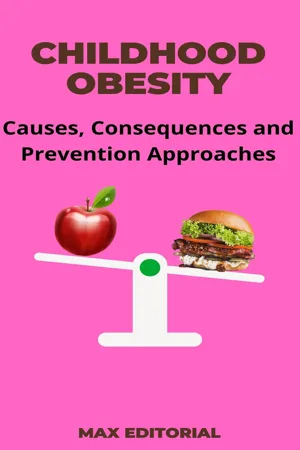
Overcoming Obesity & Achieving Full Health
Causes, Consequences and Prevention Approaches
- 48 pages
- English
- ePUB (mobile friendly)
- Available on iOS & Android
Overcoming Obesity & Achieving Full Health
Causes, Consequences and Prevention Approaches
About this book
Childhood obesity is a growing public health problem involving excessive accumulation of body fat in children and adolescents. This condition is one of the most pressing concerns today, given its substantial impact on the health and well-being of younger generations. This chapter will discuss the definition and prevalence of childhood obesity, as well as highlight the importance of the topic in the context of public health.Definition and Prevalence of Childhood ObesityChildhood obesity is characterized by excess body weight that is associated with health risks. It is often assessed using the body mass index (BMI), which takes into account the relationship between weight and height. When the BMI of a child or adolescent is above the established limits for their age group, they are considered obese. However, it is worth mentioning that childhood obesity is not just an aesthetic problem, but a health issue that is closely linked to a number of medical conditions, such as type 2 diabetes, hypertension, cardiovascular diseases and musculoskeletal disorders.The prevalence of childhood obesity has increased dramatically in recent decades. It has become a global phenomenon, affecting both developed and developing countries. The transition from less healthy eating patterns, combined with a sedentary lifestyle and constant exposure to ultra-processed foods, contributed to the spread of this problem. Childhood obesity rates vary by region and population, but in many places, the numbers are alarming and indicate a public health crisis.Importance of the Topic and Its Relevance to Public HealthChildhood obesity should not be underestimated as its implications go far beyond individual health concerns. It has a profound impact on communities, health systems and the broader economy. Obese children are at greater risk of becoming obese adults, increasing the chances of developing debilitating and costly chronic diseases. This puts a significant strain on healthcare systems, consuming valuable resources that could be allocated elsewhere.In addition, childhood obesity also influences social and emotional issues. Obese children often face discrimination, bullying and low self-esteem, which can hinder their psychosocial development. This can have lasting effects throughout life, affecting quality of life and productive participation in society.In light of these challenges, addressing childhood obesity has become a global priority. The need for effective preventive interventions, nutritional education programs, promotion of physical activity and changes in public policies is crucial to reverse this worrying trend. This book will explore these issues in detail, providing insights into the underlying causes, consequences, and multidisciplinary approaches that can be taken to tackle the childhood obesity epidemic comprehensively and effectively.
Frequently asked questions
- Essential is ideal for learners and professionals who enjoy exploring a wide range of subjects. Access the Essential Library with 800,000+ trusted titles and best-sellers across business, personal growth, and the humanities. Includes unlimited reading time and Standard Read Aloud voice.
- Complete: Perfect for advanced learners and researchers needing full, unrestricted access. Unlock 1.4M+ books across hundreds of subjects, including academic and specialized titles. The Complete Plan also includes advanced features like Premium Read Aloud and Research Assistant.
Please note we cannot support devices running on iOS 13 and Android 7 or earlier. Learn more about using the app.
Information
Table of contents
- Childhood Obesity: Causes, Consequences and Prevention Approaches
- Chapter 1: Introduction to Childhood Obesity
- Chapter 2: Genetic and Hereditary Factors
- Chapter 3: Environmental Factors and Lifestyle
- Chapter 4: Impact of Food Advertising and Marketing
- Chapter 5: Short-Term Consequences of Childhood Obesity
- Chapter 6: Long-Term Consequences of Childhood Obesity
- Chapter 7: Approaches to Prevention in the Family
- Chapter 8: School Interventions
- Chapter 9: Role of the Food Industry and Government Regulation
- Chapter 10: Multidisciplinary Approaches to Treatment and Intervention
- Chapter 11: Education and Awareness in Society
- Chapter 12: Research and Scientific Advances in Childhood Obesity
- Chapter 13: Partnerships and Collaborations to Combat Childhood Obesity
- Chapter 14: The Role of Continuing Education
- Chapter 15: Overcoming Cultural and Socioeconomic Challenges
- Chapter 16: The Future of Childhood Obesity Prevention
- Chapter 17: The Importance of Advocacy and Public Engagement
- Chapter 18: Evaluating Progress and Measuring Success
- Chapter 19: Inspiring Enduring Change in Society
- Chapter 20: The Personal Journey Towards Health
- Chapter 21: Resources and References
- Chapter 22: Closing and Call to Action
- Growth Tags :